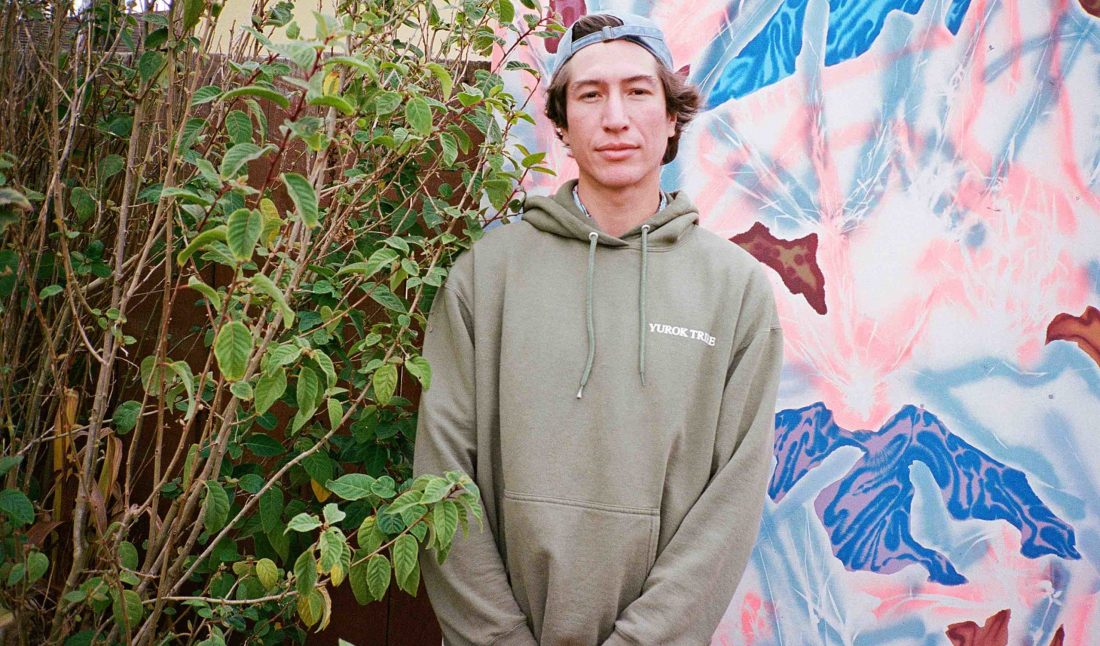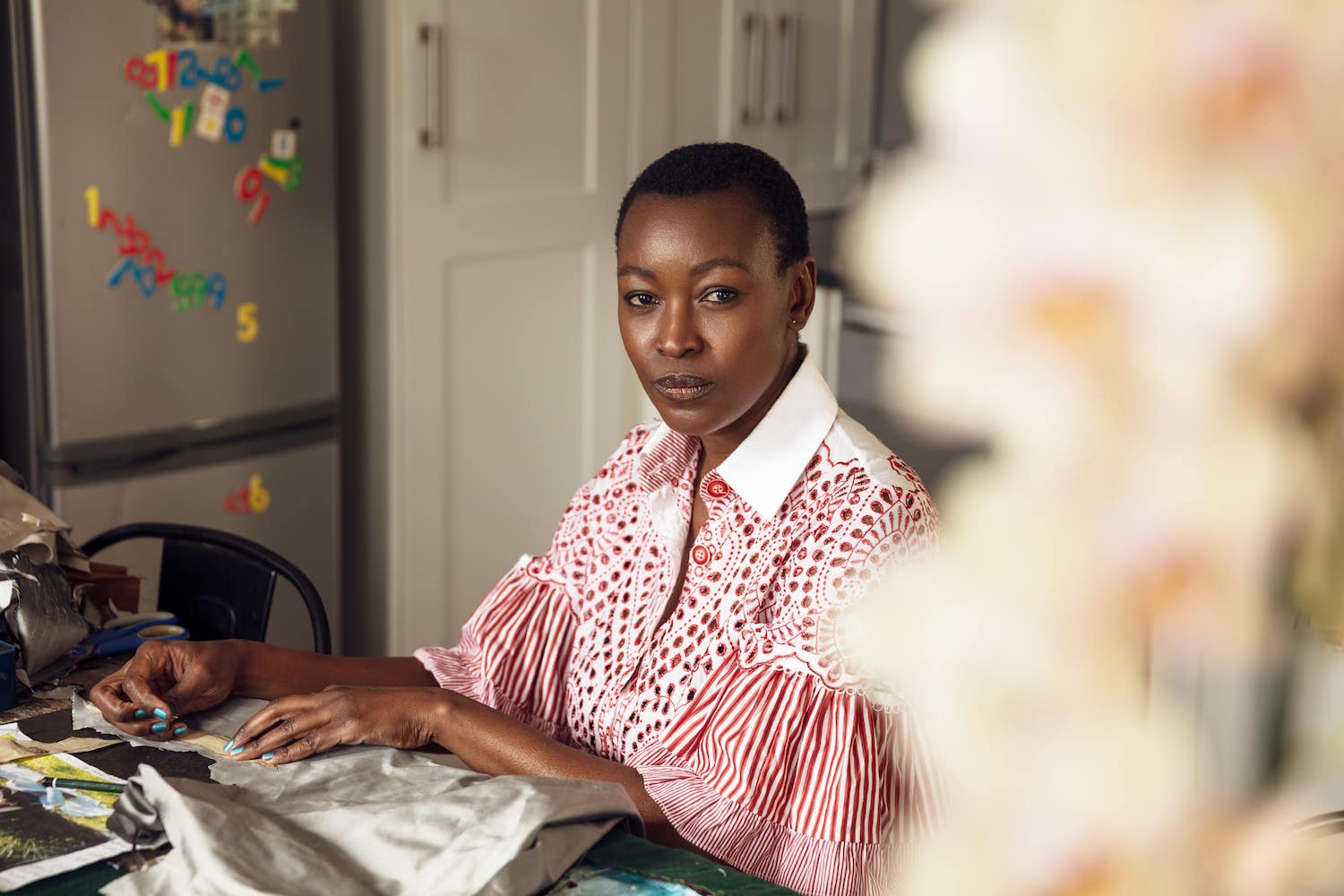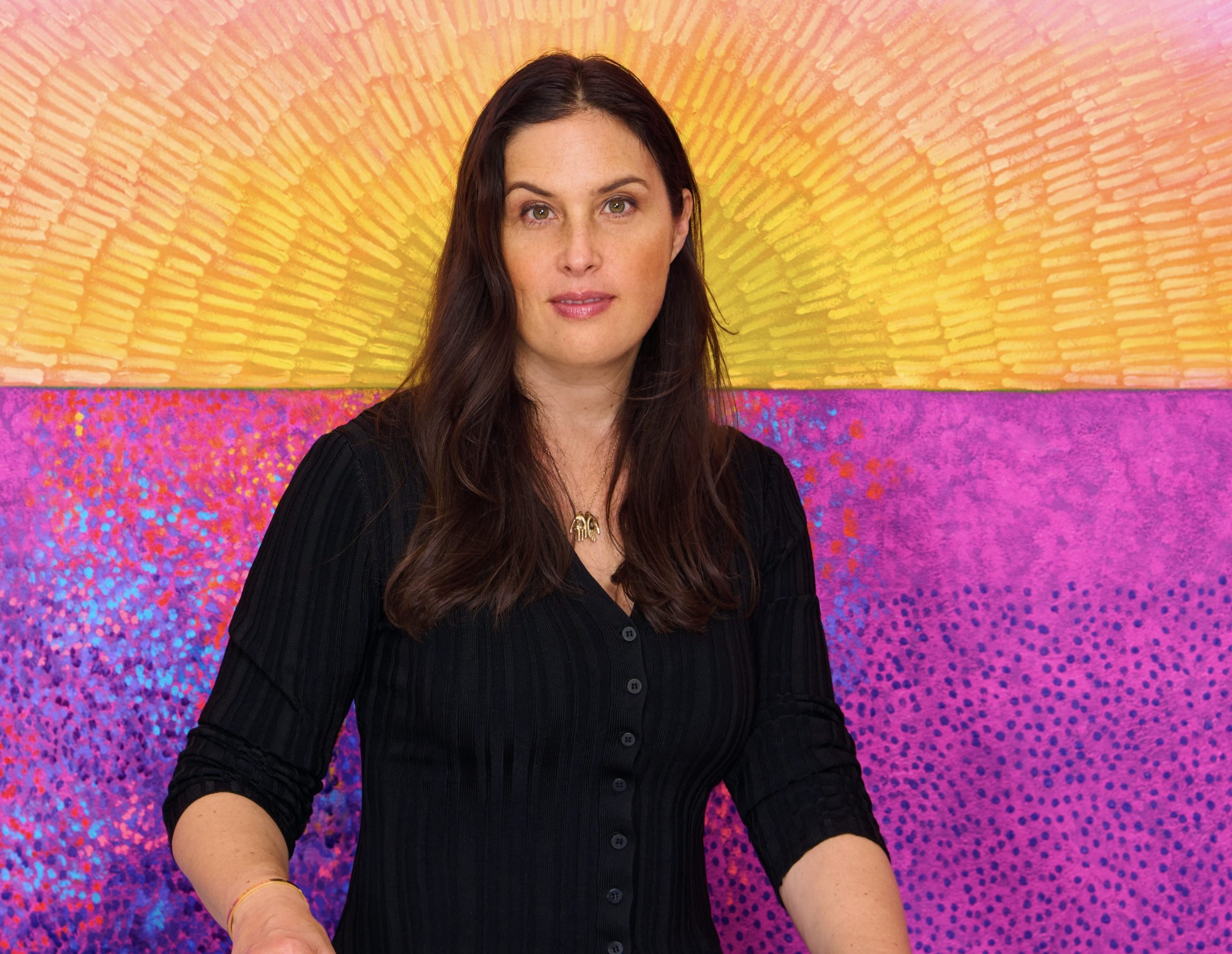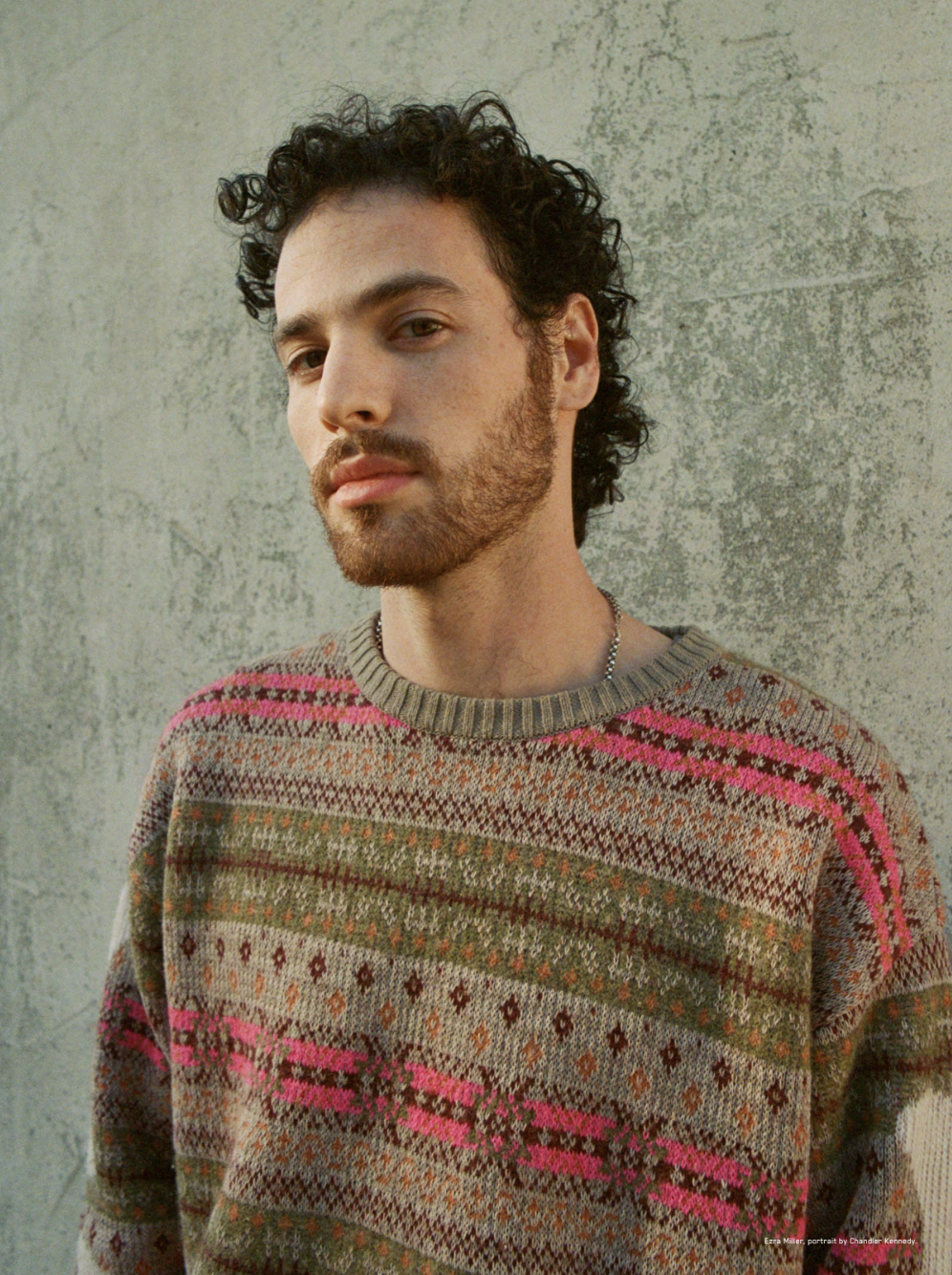Saif Azzuz’s “Huem-chor O’ weych-pues” (Welcome to where the rivers meet) is currently on view at Anthony Meier Fine Arts in San Francisco through April 22. The exhibition includes a series of new paintings, ceramics, wood sculptures, beading, and metalwork, exploring the imagery, craft, and landscape of his Yurok heritage. Growing up between two cultures—Yurok on his maternal side and Libyan on his paternal—Azzuz has always investigated that dynamic in his practice, and how it’s viewed through the lens of an American eye.
Recently, he has been looking more directly at his own relationship with the communities he’s from. His paintings are full of vibrant colors and movement, created by spraying paints and dyes pulled from a palette of California’s wildfire and drought maps—bright yellows, oranges, reds, and purples that serve as a warning. Using native and invasive plants to create shapes and patterns, he references indigenous cultural knowledge.
A few months before the solo show opened, Whitewall spoke with Azzuz about the dualities of life, landscape, and art.
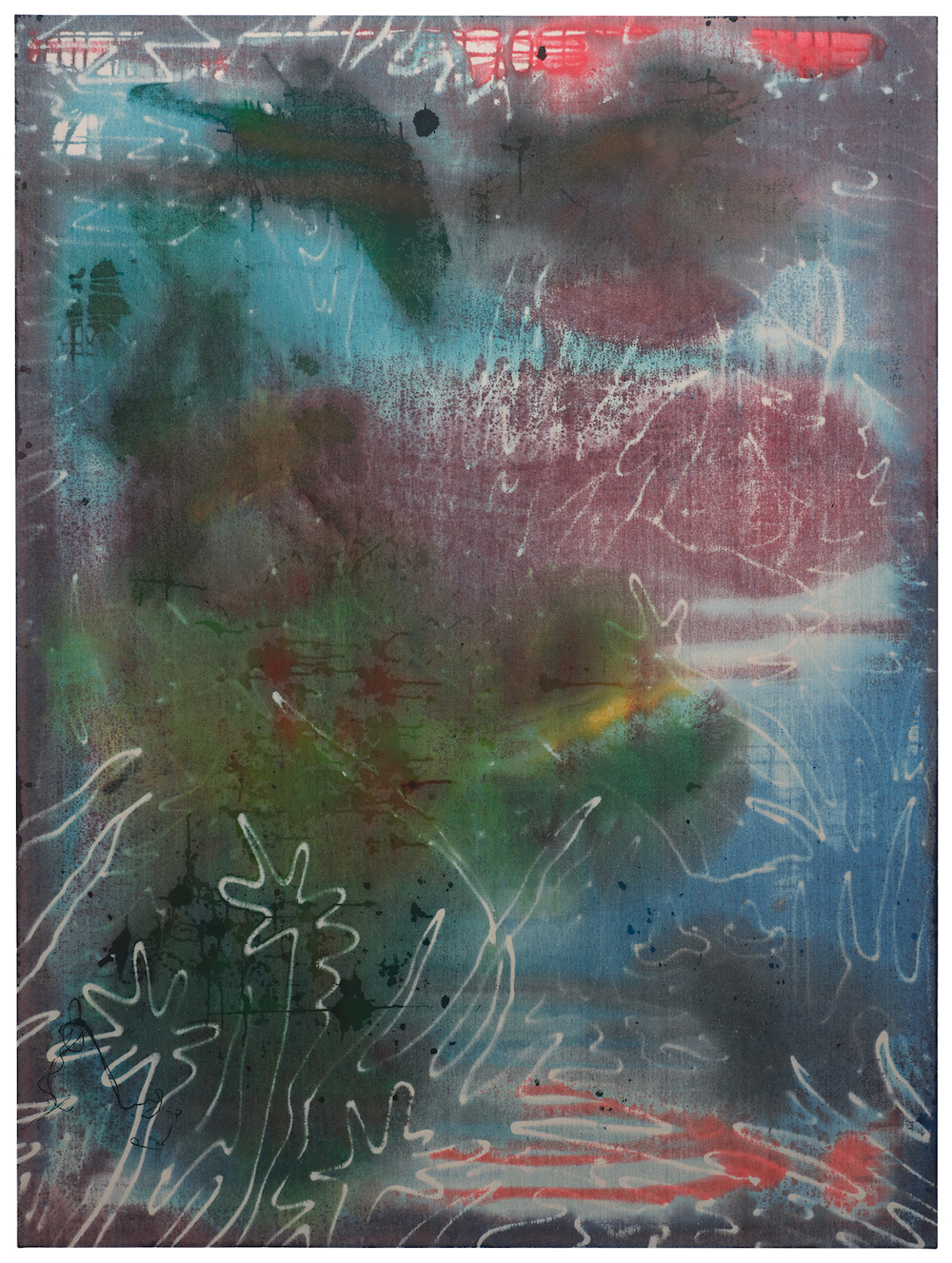 Saif Azzuz, “‘We-noohl wek ‘o serrneryk’ kue mey,” 2022, acrylic and enamel on canvas, 80 x 60 inches, photo by Chris Grunder, San Francisco, courtesy of Anthony Meier Fine Arts.
Saif Azzuz, “‘We-noohl wek ‘o serrneryk’ kue mey,” 2022, acrylic and enamel on canvas, 80 x 60 inches, photo by Chris Grunder, San Francisco, courtesy of Anthony Meier Fine Arts.
WHITEWALL: What will be on view in the exhibition at Anthony Meier?
SAIF AZZUZ: The title of the show, “Huem-chor O’ weych-pues,” which I’m butchering because I’m still learning Yurok, means “Where the rivers meet.” That’s where I grew up, on and off, and that’s where my mom lives and where my family lives. It’s on the Yurok Reservation. This show is largely about that area and all the many dualities of living there—both appreciating the land and how the inaccessibility to certain space has affected the land and water over time, and how people in the community are working to restore that.
I’m going to divide up the space with a cattle gate that would be used where my mom lives. There’s going to be some mixes of woodworking, painting, metalwork, and some other things. With the cattle gate, you don’t have access to a certain part of the space. There’s going to be work behind there that you can see but you’re not going to be able to get to.
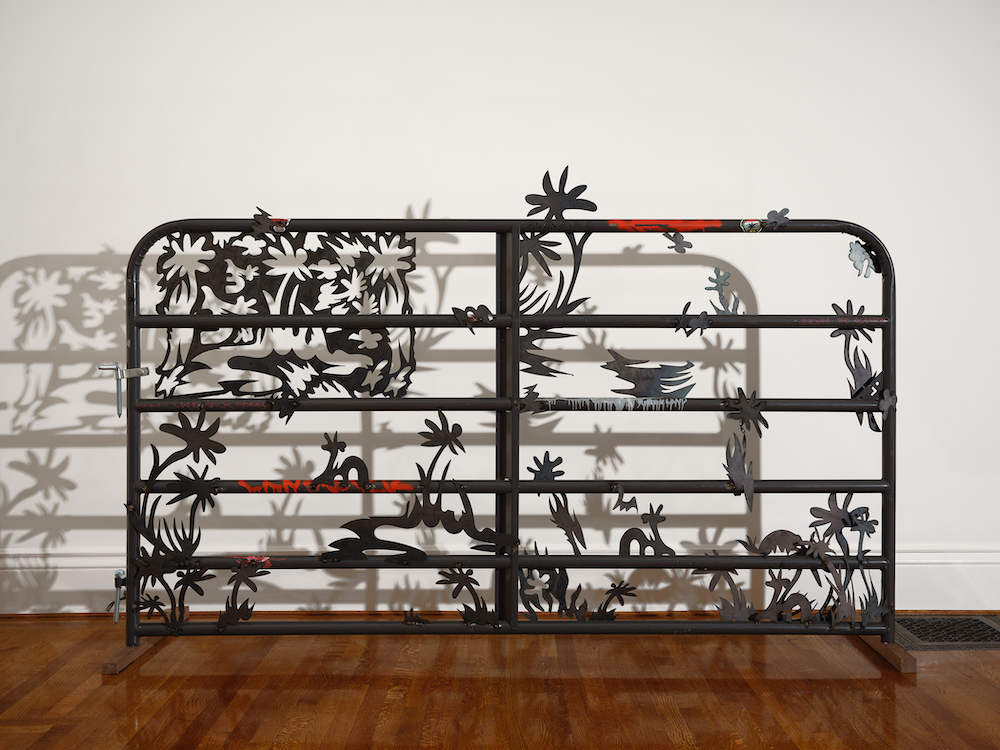 Saif Azzuz, “Who says,” 2022, stickers, ink, bungee cord, chains, and steels, 59 x 93 inches, photo by Chris Grunder, San Francisco, courtesy of Anthony Meier Fine Arts.
Saif Azzuz, “Who says,” 2022, stickers, ink, bungee cord, chains, and steels, 59 x 93 inches, photo by Chris Grunder, San Francisco, courtesy of Anthony Meier Fine Arts.
WW: Why did you want to divide the space?
SA: That tension was a big thing for me. There is that inaccessibility to ancestral space back home, especially when you are trying to care for it or gather, that you can feel. And I wanted that to be in the show.
I’m going to have 13 ceramic salmon on one wall of the gallery, and they are going to be the only thing that crosses the space in between what everyone is able to access and the area that’s gated off. I picked 13, acknowledging the lunar calendar and how it would normally function within our community.
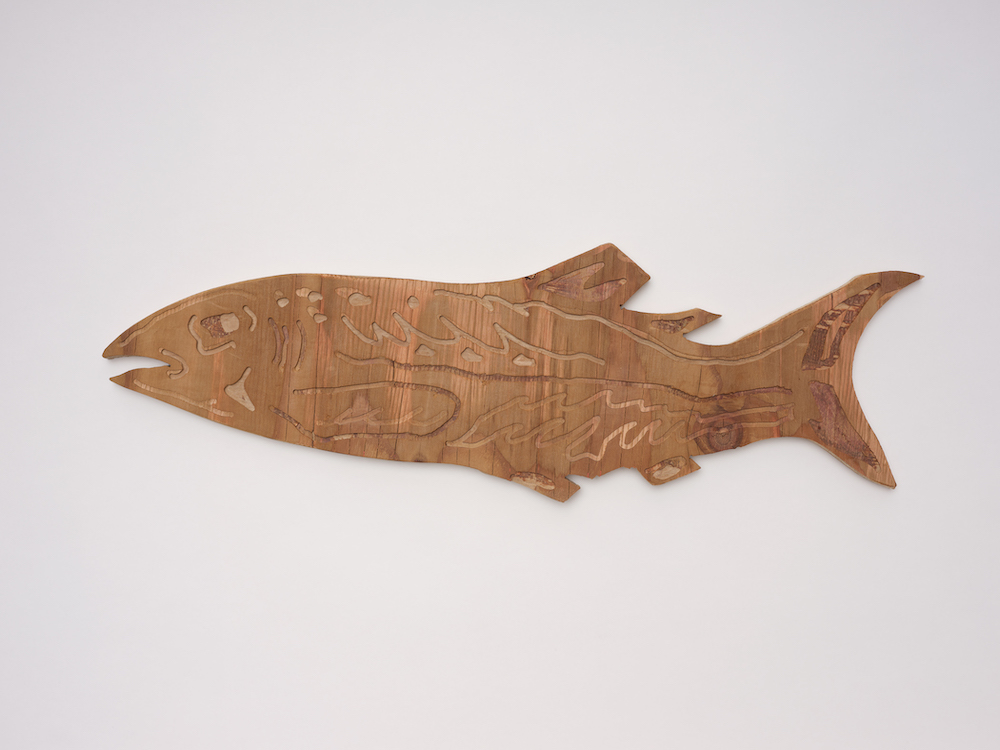 Detail installation view of Saif Azzuz, “Why you dam that?,” 2022, 13 hand-carved salmon made of redwood, plywood,cedar, acacia, cypress, pine and eucalyptus, photo by Chris Grunder, San Francisco, courtesy of Anthony Meier Fine Arts.
Detail installation view of Saif Azzuz, “Why you dam that?,” 2022, 13 hand-carved salmon made of redwood, plywood,cedar, acacia, cypress, pine and eucalyptus, photo by Chris Grunder, San Francisco, courtesy of Anthony Meier Fine Arts.
WW: What will they look like?
SA: I’m going to really try to stick to replicating fish, and I’m going to see how many ways I can do it. When you’re fishing up there, my mom’s area, or interacting with the fish you see, there are so many different ways nature has affected them. By the time they make it upstream, whatever is in there, the algae and aspects of their journey, has impacted them.
There’s also going to be a beaded piece. Beading has been a big thing within my family, and I grew up watching my great-aunts and my grandfather bead, and my mom beads. They’re reflective of our basket patterns. I remember watching my grandfather before he passed doing his last beading, and it was still on a loom, so I’m going to replicate that same pattern he was doing. For me, it felt like a good way to sit with what my grandfather was working on at the end. It’s nice to be present with the beading, because it takes a lot of time and you have to sit with it in a different way than a painting or woodworking.
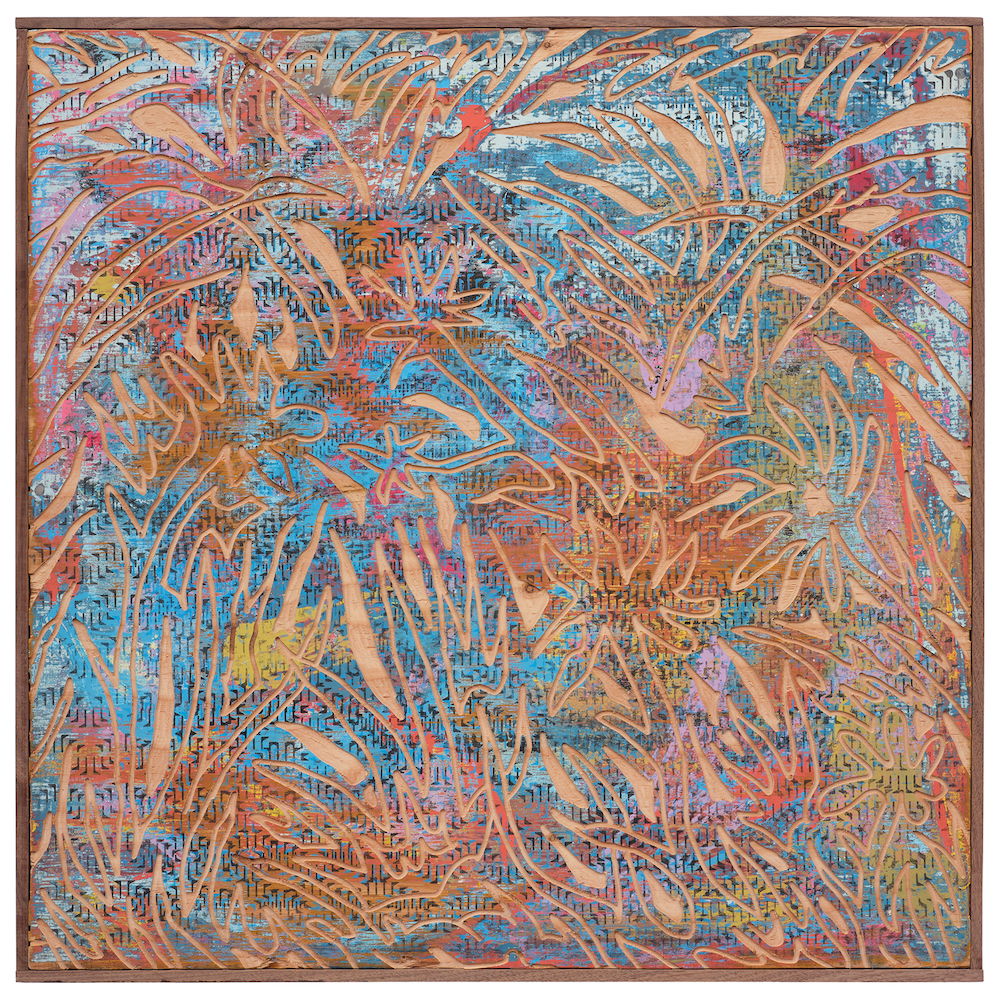 Saif Azzuz, “se’raa (carve it out),” 2022, acrylic on hand-carved plywood, 4 1/2 x 24 1/2 inches, photo by Chris Grunder, San Francisco, courtesy of Anthony Meier Fine Arts.
Saif Azzuz, “se’raa (carve it out),” 2022, acrylic on hand-carved plywood, 4 1/2 x 24 1/2 inches, photo by Chris Grunder, San Francisco, courtesy of Anthony Meier Fine Arts.
WW: What role does sourcing the wood play for you?
SA: In past instances, I’ve gotten wood that was going to be in a chipping pile or that was reclaimed. For me, it was nice to put a story back into those pieces that would end up going into someone’s yard. Within the community back home, redwoods are really important, and it’s been so removed that it was nice to be able to spend time with these pieces of redwood.
For this show, I’m finding pieces of reclaimed wood, and I’m also working with my mom, who does cultural fire stuff up there, to take down trees that are dying in certain areas. There’s an airborne pathogen that’s taken down a lot of cedar. We’ve been going and downing those trees, and some get used for cultural stuff and some I’m milling down to try to use for certain aspects of the show, like these shelves that I’m going to create and this wooden panel.
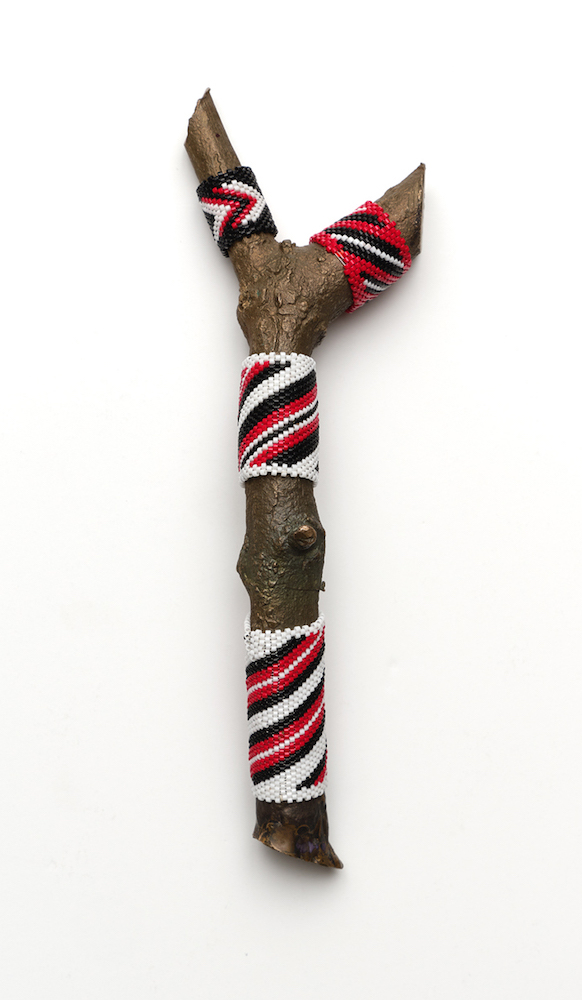 Saif Azzuz, “To be present,” 2022, glass beads on bronze, 8 1/2 x 2 3/4 x 1 1/2 inches, photo by Chris Grunder, San Francisco, courtesy of Anthony Meier Fine Arts.
Saif Azzuz, “To be present,” 2022, glass beads on bronze, 8 1/2 x 2 3/4 x 1 1/2 inches, photo by Chris Grunder, San Francisco, courtesy of Anthony Meier Fine Arts.
WW: Where do you typically start when working on a new body of work?
SA: Family is always important for me, and the land and how it’s affected always comes up. And then traditional ecological knowledge, which is this idea that before colonization, because every area was so individualized and specialized, every individual community had the best knowledge of those areas and how to take care of them. So, rather than a blanket way of taking care of a whole state, individual communities knew best. These are things I am thinking about and are starting points for me, are ways in which ancestral knowledge and taking care of the land has been affected by the shift of colonization.
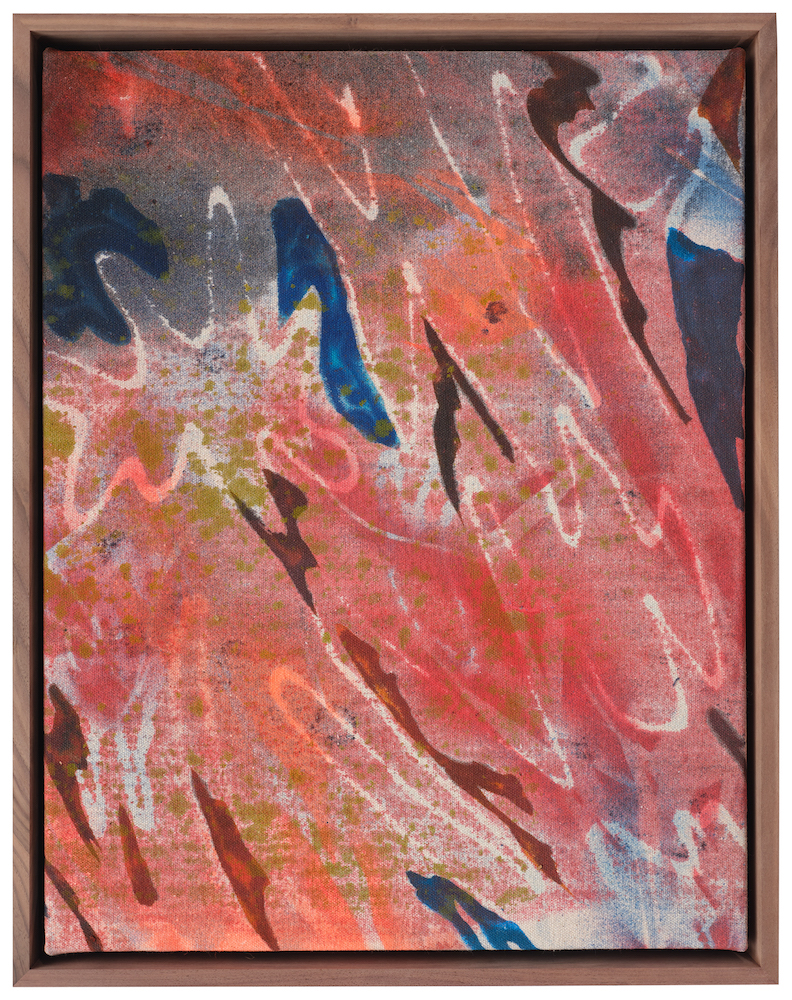 Saif Azzuz, “Cultural Fire,” 2022, acrylic on canvas in hand-carved walnut frame, 18 x 14 inches, photo by Chris Grunder, San Francisco, courtesy of Anthony Meier Fine Arts.
Saif Azzuz, “Cultural Fire,” 2022, acrylic on canvas in hand-carved walnut frame, 18 x 14 inches, photo by Chris Grunder, San Francisco, courtesy of Anthony Meier Fine Arts.
WW: I wanted to ask you about your color choice. Your paintings are so dynamic, with colors pulled from fire maps. But the works don’t read as “danger” or warnings.
SA: I’ve been sitting with that a lot. I think that’s also life, those dualities, where maybe you don’t always feel like there’s a constant danger. I get these really beautiful present moments with my family, but also there’s climate change things happening, and other really unfortunate things globally.
WW: In the show, in the section that you can see but can’t access, what work will be back there?
SA: The beaded pieces that I’m replicating from my grandfather will be back there. That’s a really intimate moment. It is a detailed thing. It pulls back to that tension of, if we talk about the dynamic of who goes to galleries, it’s a certain person socioeconomically, and they’re not used to not having access to space also. There’s something interesting about saying, “You can’t see this intimate moment.”
Everyone is so used to being able to see everyone’s intimate moments with social media. There’s something about not being able to access space that is important to me.
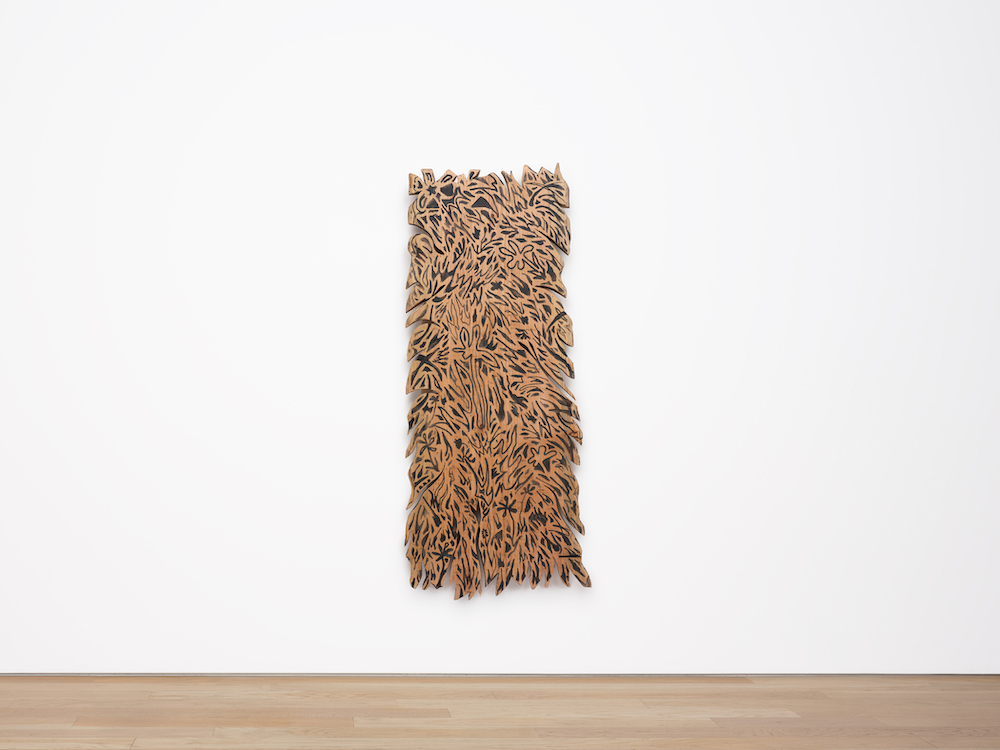 In situ view of Saif Azzuz, “And what did it say?,” 2022, enamel on cedar, 67 x 29 x 1 1/2 inches, photo by Chris Grunder, San Francisco, courtesy of Anthony Meier Fine Arts.
In situ view of Saif Azzuz, “And what did it say?,” 2022, enamel on cedar, 67 x 29 x 1 1/2 inches, photo by Chris Grunder, San Francisco, courtesy of Anthony Meier Fine Arts.






